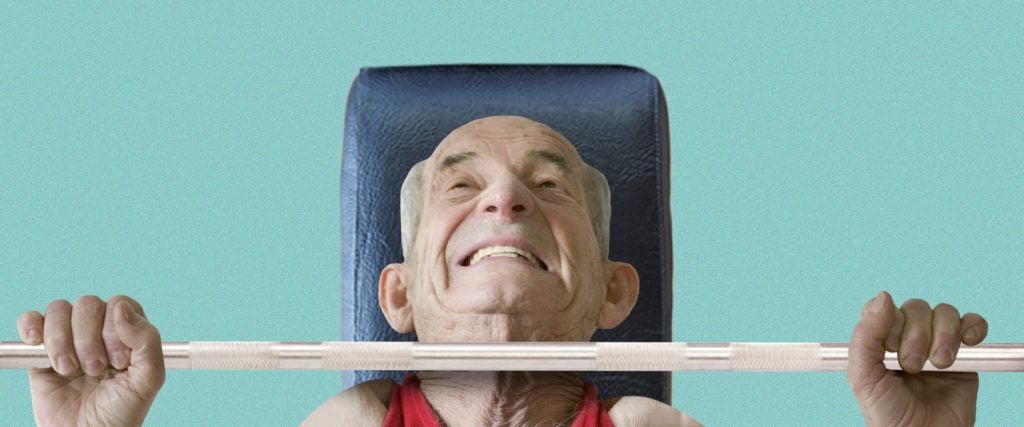As you bench press throughout your life, you’re going to notice both an obvious natural rise and then decline in the total weight you’re capable of pressing at crucial points connected with your age.
It’s certainly possible for a person who begins lifting consistently later in life to hoist loftier weight totals at age 60 than they did at age 25 — provided that they trained inconsistently or not at all during their mid 20s. But despite what the seemingly ageless gym wonders amongst us would love to believe, time is undefeated, and there is no place this is more obvious than in the weight room. We all eventually reach an age at which achieving our personal bests in lifts like the bench press become milestones that are inescapably confined to the past, and the objective shifts to slowing the gradual but unrelenting decline of our strength.
Yeah, but is there a way to project what my average bench press total is going to be based on my age?
Indeed, but all of the charts devoted to delivering such data make key assumptions, so we have to parse that information in order to truly get a sense of what it means. We also have to assume that your training practices and dietary habits remain consistent throughout your life, meaning that the average increase or reduction in the weight you’re capable of lifting from year to year — at least on a percentage basis — is reflective of your true maximum strength capacity during each era of your lifetime.
The rule-of-thumb many people follow is how much weight an average man should be able to lift at a given age, in relation to his body weight. According to this very rudimentary set of standards, a man in his 20s should be able to bench press 100 percent of his body weight. From there, a man’s capacity to bench press is projected to decline by an average of 10 percentage points during his 30s, another 10 percentage points during his 40s and five percentage points in his 50s.
Or to put it another way, a 200-pound man who could bench press his full body weight in his 20s would be expected to press 180 pounds in his 30s, 160 pounds in his 40s and 150 pounds in his 50s.
While this all sounds fairly cut-and-dried, it ignores many of the realities of a life spent training. In fact, if you were to plot where these totals would land on a chart of lifters ranging from novice to intermediate, advanced and elite, a maximum lift at 100 percent of a person’s body weight would fall in between the novice and intermediate categories.
Basically, there’s reason to believe that the strength totals being charted are linked with individuals who don’t train with any regularity, so the body-weight-percentage tracking method may be over-simplified and inaccurate for those who train regularly.
So how are we supposed to get to the bottom of this?
Fortunately, there’s another set of data that was developed to take age into consideration, even for individuals at the most elite levels of lifting prowess.
Using it, if we begin with the weight ceiling that’s achieved by an advanced lifter and track it at five-year intervals, we can see that the weight a young man is capable of bench pressing at an advanced training level increases by nearly 15 percent between the ages of 15 and 20 — from 245 pounds to 281 pounds. From there, that same man can expect his strength level to increase by another 2.5 percent to 288 pounds by the time he reaches the age of 25. At that point, his strength would be expected to peak and remain at that level until he reaches the age of 40.
It’s at this stage where the reality of age-related limitations are expected to noticeably creep in. A 5-percent decline in pressing power occurs between the ages of 40 and 45. Then, between ages 45 and 50, strength dips a further 7 percent. At this stage, a man’s strength level is reduced by an average of 10 percent every five years until he reaches 90 years old.
It sounds like men are losing a staggering amount of strength as they age!
Yes they are, but the drop probably isn’t quite as precipitous as it sounds.
The percentage of strength being drained from the maximum bench-pressing total is being compared with the previous five-year mark, and isn’t being gauged against the lifter’s absolute peak level of strength. In other words, a 10-percent decline in strength represents a smaller dip from one five-year period to the next. All things considered, an advanced lifter should expect to lose 60 percent of his strength from when he’s at the peak of his potency between the ages of 25 and 40 by the time he’s reached 90.
For what it’s worth, the 113 pounds that an advanced 90-year-old lifter could expect to lift exceeds the projected bench-pressing totals for beginning lifters at all age levels. Basically, as long as you try your damndest to stay in shape into your 90s, you should still be powerful enough to put your great-grandson in his place if the young punk gets disrespectful with you at the nursing home dinner table.

